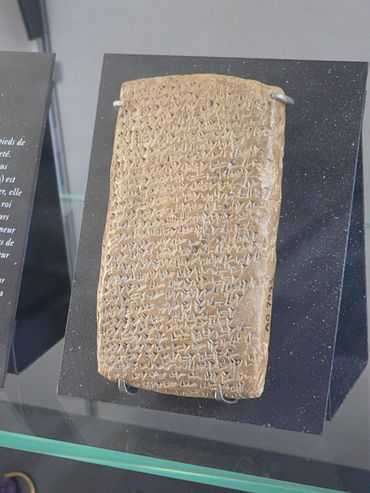Amarna letter EA 289

(very high-resolution expandable photo)
Amarna letter EA 289, titled: "A Reckoning Demanded,"[1] is a moderately tall, finely-inscribed clay tablet letter, approximately 6.5 in tall, from Abdi-Heba the mayor/ruler of Jerusalem, of the mid 14th century BC Amarna letters. The scribe of his six letters to Egypt were penned by the "Jerusalem scribe"; EA 289 is a moderately long, and involved letter, mentioning named individuals, some more that three times. A total of nine locations are referenced, as well as men of the "Hapiru"-("LÚ-MEŠ-Hapiru-ki"),[2] and men of "Qilyi-ki".
The Amarna letters, about 300, numbered up to EA 382, are a mid 14th century BC, about 1350 BC and 20–25 years later, correspondence. The initial corpus of letters were found at Akhenaten's city Akhetaten, in the floor of the Bureau of Correspondence of Pharaoh; others were later found, adding to the body of letters.
Letter EA 289 (see here-(Obverse): ), is numbered VAT 1645, from the Vorderasiatisches Museum Berlin.
The letter
EA 289: "A Reckoning Demanded"
EA 289, letter five of six. (Not a linear, line-by-line translation, and English from French.)[3]
- (Lines 1-4)--[Say t]o the king, my lord: Message of 'Abdi-Heba, your servant. I f[all] at the feet of my lord, the k[ing], 7 times and 7 times.
- (5-10)Milkilu does not break away from the sons of Labaya and from the sons of Arsawa, as they desire the land of the king for themselves. As for a mayor who does such a deed, why does the king not (c)all him to account?.
- (11-17)--Such was the deed that Milkilu and Tagi did: they took Rubutu. And now as for Jerusalem-(URUUru-Salimki), if this land belongs to the king, why is it ((not)) of concern1 to the king like Hazzatu?
- (18-24)--Ginti-kirmil belongs to Tagi, and men of Gintu are the garrison in Bitsanu.2 Are we to act like Labaya when he was giving the land of Šakmu to the Hapiru?
- (25-36)--Milkilu has written to Tagi and the sons ((of Labaya)), "Be the both of you a protection.3 Grant all their demands to the men of Qiltu, and let us isolate Jerusalem."4 Addaya has taken the garrison that you sent in the charge of Haya, the son of Miyare; he has stationed it in his own house in Hazzatu and has sent 20 men to Egypt-(Miṣri). May the king, my lord, know (that) no garrison of the king is with me.
- (37-44)--Accordingly, as truly as the king lives, his irpi- official,5 Pu'uru, has left me and is in Hazzatu. (May the king call (this) to mind when be arrives.)6 And so may the king send 50 men as a garrison to protect the land. The entire land of the king has deser[ted].
- (45-46)--Send Ye((eh))enhamu that he may know about the land of the king, [my lord].
- (47-51)--To the scribe of the king, [my lord: M]essage of 'Abdi-Heba, [your] servant, Offer eloq[quent] words to the king: I am always, utterly yours.7 I am your servant.--(complete Obverse & Reverse, EA 289, minor, restored lacunae, (and a small corner of clay tablet missing), lines 1-51)
List of Individuals, Places, or Peoples in EA 289
A list of the people of EA 289, cities, towns, or countries, and equivalent 'groups of peoples':[4]
|
Individuals:
|
Placenames or Peoples:
|
See also
| Wikimedia Commons has media related to Amarna letters. |
External links
- Photo, EA 289: Obverse
- Photo, EA 289: Obverse & Reverse, CDLI no. 271091 (Chicago Digital Library Initiative)
References
- ↑ Moran, William L. 1987, 1992. The Amarna Letters. EA 289, A Reckoning Demanded, p. 332-333.
- ↑ EA 289: Reverse, line 24., CDLI no. 271091 (Chicago Digital Library Initiative)
- ↑ Moran, William L. 1987, 1992. The Amarna Letters. EA 289, A Reckoning Demanded, p. 332-333.
- ↑ EA 289: Reverse, line 24., CDLI no. 271091 (Chicago Digital Library Initiative)
- Moran, William L. The Amarna Letters. Johns Hopkins University Press, 1987, 1992. (softcover, ISBN 0-8018-6715-0)
- Parpola, 197l. The Standard Babylonian Epic of Gilgamesh, Parpola, Simo, Neo-Assyrian Text Corpus Project, c 1997, Tablet I thru Tablet XII, Index of Names, Sign List, and Glossary-(pp. 119–145), 165 pages.